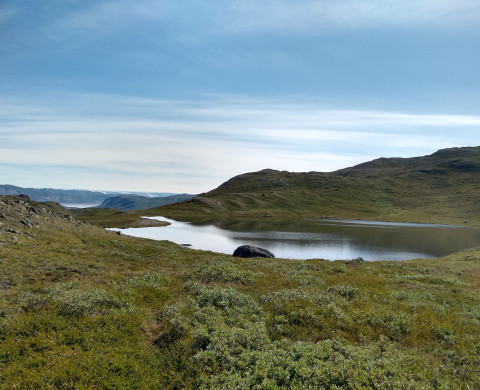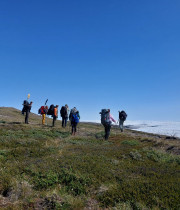CLIMET: Climate feedbacks and methane cycling in Arctic lakes - enzymes to atmosphere

Arctic lakes are important hotspots for the microbially- mediated production and cycling of methane (CH4), a potent greenhouse gas. The Arctic is warming nearly four times faster than the global average, changing polar ecosystems and with it the potential for positive or negative climate feedback effects. Rising temperatures are changing terrestrial vegetation cover, melting permafrost soils, and increasing glacial discharge from ice caps and ice sheets. Consequently, CLIMET focuses on two potential drivers of lake CH4 cycling in West Greenland that are changing rapidly as Arctic ecosystems change.
The first is dissolved organic matter (DOM) which is carried by water from the land to lakes and whose quality and quantity are shifting as the Arctic becomes greener and permafrost melts. The second is dust which is carried by wind and originates from particulate-laden outwash from the Greenland Ice Sheet (GrIS) (and other glaciers). Such environmental changes could be highly consequential for the micro-organisms and microbial community interactions in that drive methane cycling in Arctic lakes, and yet this remains a major knowledge gap. DOM is achemically diverse carbon source which has the potential to supply the microbial CH4 cycle in complex ways, whereas dust is a potential source of scarce elements, including phosphorus, lanthanides and other rare earth elements which could relieve nutrient limitation for CH4-cycling micro-organisms in lakes. The recent discovery of lanthanide-dependent enzymesin methanotrophic bacteria indicates that lanthanide availability could be much more important for CH4 cycling than previously realised. Understanding how DOM and dust influence the complex microbial processes and communities involved in CH4 cycling is essential to understand Arctic climate feedbacks, and a multi-scaled approach is needed, over space and time. CLIMET focuses on a well-studied lake district as a living laboratory in West Greenland,and assembles experts in microbiology, microbial ecology, lake ecosystems, geoscientists and palaeoecology to conduct investigations across scales ranging from the genes and enzymes to lake ecosystem processes that lead to CH4 emissions into the atmosphere. The combination of approaches will allow understanding of short-lived metabolic processes up to ecosystem and landscape-scale changes over centuries. Overall the aim of CLIMET is to uncover the microbial processes that drive methane emissions in Arctic lakes, determine how they are affected by climate warming and elucidate long-term interlinkages among climate, landscape, microbes and CH4.
Media snippet
The highs and lows of fieldwork in Greenland
Researchers from NIOO have been in West Greenland investigating methane cycling in Arctic lakes. The aim of this first field visit was to assess variability in lake conditions and microbial composition across the low arctic landscape of Kangerlussuaq.
Blog by Suzanne McGowan

Experts
-

-
Paul Bodelier
Senior Researcher , Microbial Ecology
-
Ate Hendrik-Jan Jaarsma
Postdoc , Microbial Ecology
-
Fleur van Crimpen
Postdoc , Aquatic Ecology
